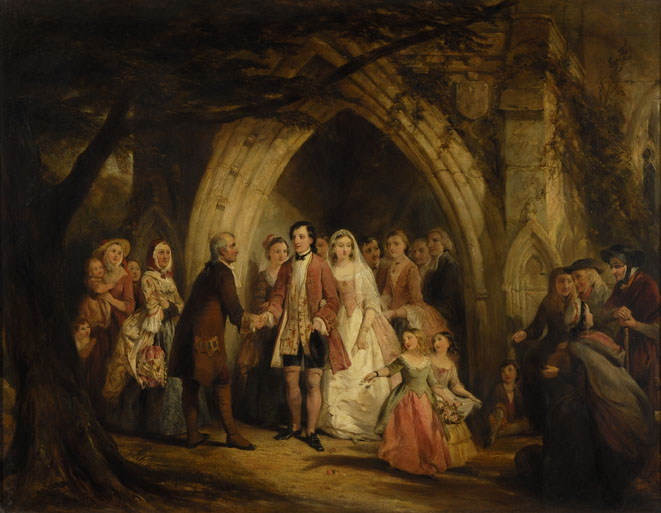The Young Squire's Wedding
|
Research by Marjorie Gregson & Sally Banister
|
|
Acc No 2
Artist Thomas Falcon Marshall Artist dates 1818-1878 Medium oil on canvas Size 69.9 x 90.2 cm (27.5 x 35.5 in) Date painted 1845 Inscr: signed and dated Donor Sarah Ellen Crompton 25 Ansdell Road North, Lytham St Annes Date donated 23 December 1946 Also donated On the River Dee (E Bennett) Easedale, Westmorland (E Bennett) Clovelly Harbour (S Towers) |
|
ARTIST
Thomas Falcon Marshall was born in Liverpool in 1818 and was a prolific painter of cottage interiors, rustic, farmyard and historical scenes, for which he had been greatly influenced by Oliver Goldsmith, Byron and others. However, his work also included portraits and watercolours. He was a great admirer of William Frith. Marshall was an Associate, then member of the Liverpool Academy and was well represented in the Liverpool and Manchester exhibitions throughout his life. In 1840 he won a silver medal at the Society of Arts for an oil painting of a figure subject. In total he exhibited 60 works at The Royal Academy, 42 at The Suffolk Street Gallery in London and 40 at The British Institution. Although living in London for much of his life, he died in Chorlton, Lancashire in 1878. He was survived by his wife, Amelia Jane, and his children, one of whom, William Elstob Marshall, born 1843, was also an artist. His work is displayed in museums in Liverpool and London and in galleries in Australia. Other works include Emigration – The Parting Day was inspired by the work of 18th century poet and playwright, Oliver Goldsmith.'Good heavens; what sorrows gloom’d that parting day....' It is now in the Art Gallery of South Australia, Adelaide. It was exhibited in 'Exiles and Emigrants: Epic Journeys to Australia in the Victorian Era' in the National Gallery of Victoria, Melbourne and in the National Museum of Canberra in 2006. The Gipsy Calderdale Metropolitan Borough Council Rest from Haymaking Travellers outside a Tavern John Howard visiting the Prisons in Italy National Museum of Liverpool Returning Health Worthing Museum and Art Gallery The Arrest of Louis XV1 and his Family at Varennes in June, 1791 One of his paintings, of a young girl and child observing sheep, hung over the mantelpiece in the sitting room of the poet, Philip Larkin. PAINTING This painting was previously catalogued as The Village Wedding (Stephen Sartin 2001) but later research (2016 ) revealed its original title as The Young Squire's Wedding: receiving the congratulations of his tenants; a scene of the Olden Time. The 1845 catalogue entry was accompanied by this charming little poem: "Soon issuing forth shall glitter through the trees Vestures of nuptial white; and hymns be sung And violets scattered round, and old and young Stand still to gaze, and gazing bless the scene, While her dark eyes declining, by his side Moves in her virgin veil the gentle bride. - Vide 'Human Life', A Poem by S Rogers" The scene takes place in Georgian times as is evident by the style of dress. The groom is wearing the long frock coat, embroidered waistcoat, short breeches, silk stockings and lacy cravat, which would have been the appropriate dress for an upper class wedding. He is not wearing a wig but has his own hair tied back. The bride is wearing a white dress, although Georgian wedding dresses in white were not commonly worn. It was the marriage of Queen Victoria in 1840 which made them popular. Brides in the mid-18th century often wore a best dress which could be worn again. Lower social classes often wore dark, more practical colours. Caps or bonnets were the usual headwear. Bridesmaids, who were usually younger sisters or cousins, did not have matching outfits as is now the custom. Marriages were usually private affairs, sparsely attended by close relatives. In this painting the groom and bride stand in the archway whilst the relatives gather behind. The wedding party is bathed in light so the eye focuses on the carefully grouped figures. The surrounding trees and shadows frame the scene, which is painted in warm colours. The minister is shaking the groom’s hand, whilst to the left and right of the central group are the villagers and what appears to be a beggar propped against the church wall. The overall effect is one of restraint: the expressions on the faces rather solemn. The use of light and shade gives the painting depth and the mellow stonework of the church forms a harmonious background. |
REFERENCES
www.bbc.co.uk/yourpaintings www.studiointernational.com www.artcyclopaedia.com www.european-artgallery.com Brennan, Maeve, 'The Philip Larkin I knew' www.findmypast.co.uk Oxford Dictionary of National Biography www.spinningtheweb.org.uk Commonwealth War Graves Commission www.amounderness.co.uk Mason, Dennis Hurlstone, 'Fair Domes of Fairhaven' Sartin, Stephen, Fylde Borough Collection of Works of Art catalogue, No 5, August 2001 Morris, Edward & Roberts, Emma, The Liverpool Academy & Other Exhibitions of Contemporary Art in Liverpool 1774-1867; A History and Index of Artists and Works Exhibited, pub Liverpool University Press & National Museums & Galleries on Merseyside, 1998, ISBN 0-85323-672-0 p 415 |

